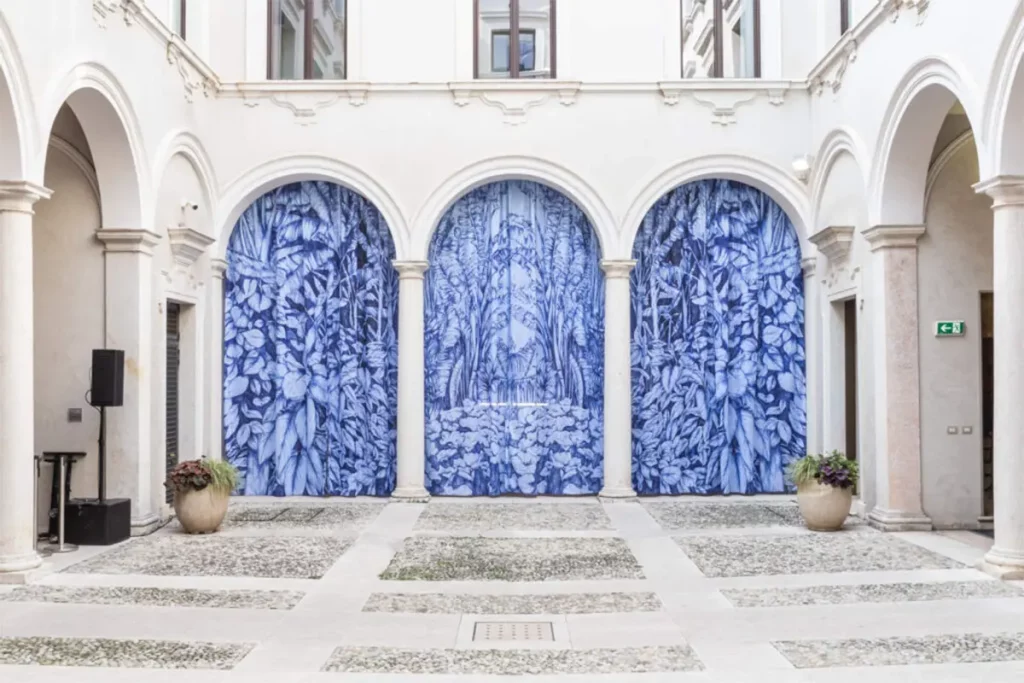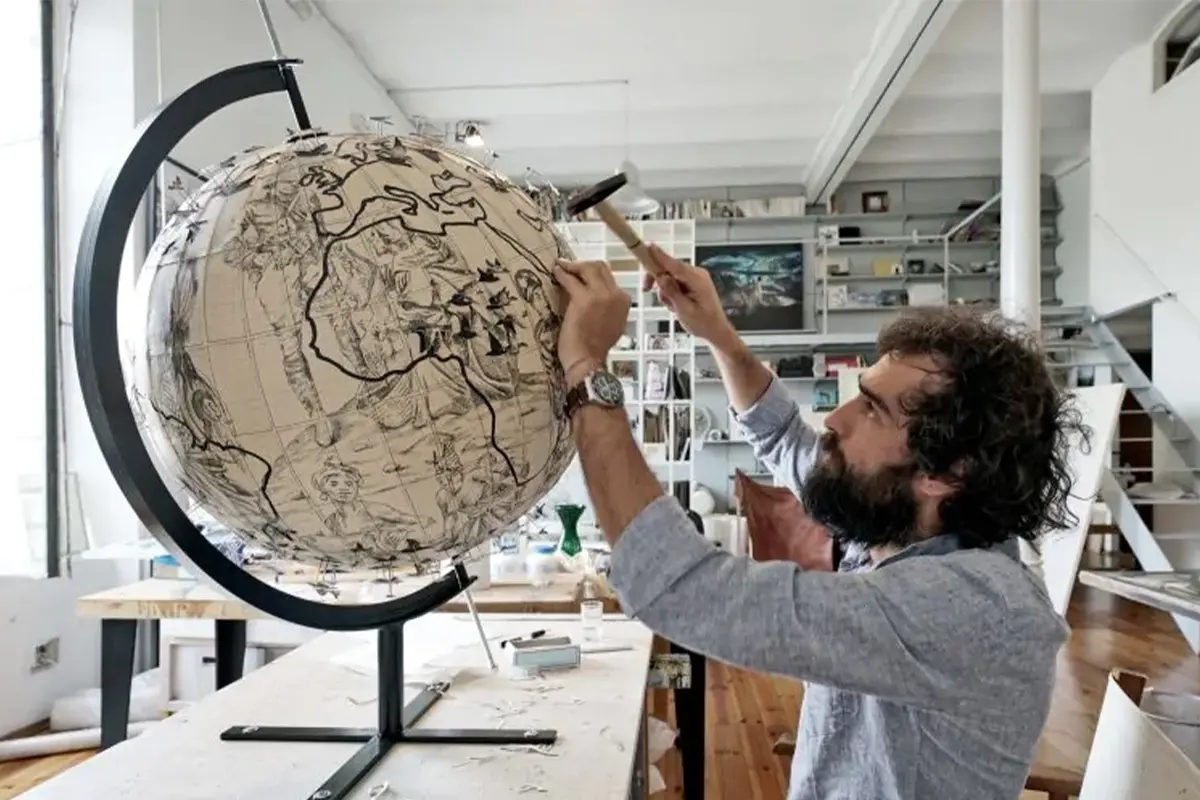Geographic maps and writing, geometric overlays and experimentation with different materials: the breakdown of Pietro Ruffo’s operas and career
From architecture to art: the career of Pietro Ruffo
Pietro Ruffo has a background of studies that is based on architecture, and in his works he has brought several elements that relate to his studies. Already in the realization of a project, the artist follows the same steps as the architect starting from the site visit. Thus, the first approach is that of a visual and then cartographic survey of the place where the work will be placed. Fundamental to this stage is the architect’s use of various cartographies, from aero-photogrammetry to morphological maps.
The analysis for the architect closes with an urban sociological survey to understand the needs and ambitions of the people who inhabit the place. Both of the latter two aspects are part of Ruffo’s artistic practice, starting with the predilection of paper material in the realization of his works.
«Effectively, maps are a tool that allows you to read pieces of history. Because these are never an objective tool but vary on different aspects depending on who drew them and especially who commissioned them and in what historical period». The subjectivity of the map is crucial to reading different times and places. Ruffo takes up this practice by devising a well-defined project underlying the artistic rendering of his work. His works never derive from instinctiveness, and this is also reflected in the development of his studio, where he shares the stages of project development with his collaborators, the artist explains, as in an architectural firm.
The choice of the material for each artwork
The design of the work according to Ruffo thus originates from the place in which it subsequently fits. Among the materials chosen over the years to express himself, the artist prefers paper as he feels close to the figure of the drawing maker. In addition to sketching the paper is worked with carvings, with the use of pins then the artist creates layers reaching different levels of layering of his work. The idea of many narratives coming together in one medium is a recurring theme in Ruffo’s work.
«There were times when I found other techniques of working, for example in the work Tidal Wave (2020) I was presenting these big walls made with azulejos». Sometimes the choice of material has a physical and functional purpose in relation to what needs to be accomplished. Other times it finds in the chosen form and material a meaningful and historical connection. These two reflections on design can in Ruffo’s art coincide, as in Tidal Wave.
The tradition of Azulejos
This technique of fine art draws on Portuguese, southern Italian and North African traditions, the artist explains, and through a mineral varnish then fired, the design is imprinted on the azulejos. In this case, the use of a medium other than paper but one that enables the same kind of expressiveness allowed Ruffo’s work to be taken outdoors. The functional idea with respect to the material is part of the choice for the specific use in the artwork being designed.
Pietro Ruffo, Tidal Wave
Moreover, in the specific case, it allowed the artist to express himself according to his authentic trait by mimicking through painting the drawing. On the conceptual issue, however, in Tidal Wave the azulejos speak of the theme of water just as in the Portuguese tradition they were linked to the representation of scenes related to the sea, boats, and encounters between peoples. This is because wealthy patrons of the time owned ships and traded with South America and Asia, Ruffo explains.
Tidal Wave picks up on these themes starting with the first wall, which addresses the question of the Mediterranean and migration. The second wall is dedicated to a garbage dump in Brazil filled with empty water bottles and the people who inhabit it, while the third takes up the Fridays For Future demonstrations by bringing back original posters that warn such as, «We are at our throats» or «Let’s raise our voices not the sea level».

Anthropocene: the human being at the center
The topic of the Anthropocene is also discussed in the contemporary because of the attribution of meaning to the term itself. Ruffo explains, «We are all aware that humans have a major impact on nature in general, the committee appointed to discuss the topic is concerned with whether this impact can be defined as a change of geological era».
The actuality and debate around this era is explored in Ruffo’s recent piece called Anthropocene. The series of works investigates how some places have changed during the presence of human beings, so about the last 200,000 years if homo sapiens is taken as a reference. Humans are undoubtedly an accelerator of certain environmental conditions, but they are also a species that has adapted very well to these changes, the artist points out.
Each piece in the series examines a specific place where ancestral remains have been found and seeks to understand how the landscape has changed and along with it the habits of the inhabitants. By means of machinery and the study of paleoclimatology, the type of vegetation and environmental changes recorded are proposed with a stratification from the temporal meaning in Anthropocene.
From Flags to Anthropocene: the role of the artist by Pietro Ruffo
The artist according to Pietro Ruffo is like a mirror of his own contemporaneity and reproduces it in different forms, spaces, dimensions, even with filters. A thought about his own contemporaneity and a projection into the future are what has distinguished Ruffo’s work throughout his career. From Flags, his first work, to Anthropocene, his most recent, major contemporary themes have been addressed.
The first was a work on the concept of self-defense and drew on the conflicts in Israel and Syria, then he talked about freedom and migration. Over the years these universal themes that accompany history return to current events, as if our species still cannot emancipate itself from these themes, the artist explains. Issues that have also been urgent in the past are reanalyzed through art by connecting historical and contemporary in Ruffo’s works.
Regarding these subjects we keep asking the same questions, never actually solving them, he points out. Art, with respect to current events as well, can create discussion on hot topics. «Each work is never an exclamation point, but always an interrogative one in which the artist questions along with the viewer of the work or provides tools for the viewer to question», Ruffo concludes.
Universal themes and their relativization to history
Approaching the different subjects in the making of an artwork Ruffo starts from a basic reflection that then leads to an in-depth study. Each topic is treated by relativizing it with respect to specific historical moments without focusing solely on the present that humanity is experiencing.
The narrative then becomes, through the works, broad and layered addressing issues relevant today such as migration or the anthropocene on a basis of comparison that goes beyond the present approach to these themes. «At the heart of his work are major themes of universal history, particularly the freedom and dignity of the individual constantly threatened by the massification taking place in contemporary society», the artist points out.
The approach to the environment, the search for identity as well as the theme of migration are central elements in Ruffo’s works. Discussing the last he dwells on the issue that migration is a constant that has accompanied man since he set foot on this planet. And that is what interests Ruffo in his work: dealing with contemporary issues but relativizing them in a history of man or the planet that has broader time frames.
Pietro Ruffo and the fashion world: from Valentino to Dior
The connection between the artist and the world of fashion was born in 2015 when through his drawings he created a large set design for Maison Valentino. Located between Piazza Mignanelli and Piazza di Spagna, the Mirabilia Roma project started from the concept of stratification that characterizes the city. Collaborations with the brand continued, and in 2017 Maison Dior involved Ruffo to celebrate the brand’s seventieth anniversary at Les Invalides.
The two-thousand-square-foot art installation depicted the journey Mr. Dior took in 1952 to present his collection around the world. His way of collaborating with the fashion industry changed in 2020: when he also began to be involved in designing some prints. In addition to the sets then Ruffo began to join Maria Grazia Chiuri and her design team for the occasion of a cruise collection with as many as 250 designs. The collaboration with the brand continues to this day for prints that Dior then develops on various types of supports.
Pietro Ruffo
Pietro Ruffo was born in 1978 in Rome, where he now lives and works. After studying Architecture at the University of Roma Tre, in the year 2010-2011 he held a research fellowship at Columbia University in New York.



















